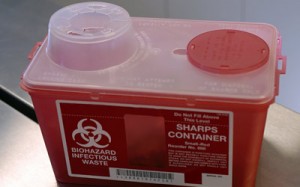People find me in google searches – it happens! – and when they do they fire away with questions. Like this one August 5, 2016:
I saw your web page and the invite to contact you with questions about the transportation of hazardous materials. My questions involve the shipping of used medical devices.
Example 1. A used biopsy sampling gun from a hospital being returned to the manufacturer for failure investigation.
Example 2. A used medical machine which collects urine which is being returned to the manufacturer for:
a) Reconditioning and return to same hospital or,
b) Disposal if broken.
Example 3. A used medical ultrasonic machine which comes in contact with various patients skin which is being returned to the manufacturer for reconditioning and return to same hospital.
Example 4. A used catheter being used for personal home healthcare being returned to the manufacturer for failure investigation.
It may be precautionary assumed that recondition / reusable devices being returned from a healthcare facility came in contact with bodily liquids from floors or sprays from patients.
It is also assumed that these liquids are Category B infectious substance.
What are the suggestions for each Example:
- Shipping Name
- Inner Packaging Material and Markings
- Outer Packaging Material and Markings
- Acceptable types of transportation (i.e. personal cars, company sales cars, licensed carriers, etc)
Also can any regulated hazardous material be shipped to any off-site storage facility while awaiting decision dispositions?
Thank you very much Daniel.
I was impressed – and a little intimidated – by the depth of his questioning:
Yow! That’s a lot. I’ll do my best to answer your questions in the next several days.
And several weeks later, I did (9.26.16):
I will do my best to answer your questions below. I apologize for my delay.
- All of what you describe meets the definition of a Used Health Care Product at 49 CFR 173.134(a)(8).
- There is an exception from regulation as a hazardous material for used health care products at 49 CFR 173.134(b)(12)(ii). Per this exception, a used health care product is not subject to USDOT regulations if the following conditions are met:
- UHCP are drained of all free liquids.
- UHCP are placed in a water-tight primary container.
- Primary container is puncture-proof if required by UHCP.
- BioHazard marking is displayed on primary container.
- Primary container is placed in water-tight secondary container.
- BioHazard marking is displayed on secondary container.
- Secondary container is placed in outer packaging.
- Sufficient cushioning is used to prevent movement of secondary container within outer packaging.
- An itemized list of contents of secondary container and information regarding possible contamination with Division 6.2 infectious substance is placed between the secondary container and the outer packaging.
- Persons involved in offering for transport or actual transport must know about the requirements of this exception. HazMat Employee training is not required.
If packaged as summarized above (and explained in detail at 49 CFR 173.134(b)(12)(ii)), no other requirements of the USDOT Hazardous Material Regulations apply.
- Shipping name: None.
- Inner packaging material and markings: see above.
- Outer packaging material and markings: see above.
- Acceptable transportation: Any. If the above is complied with, UHCP is not subject to USDOT regulation as a hazardous material.
Can any regulated HazMat be shipped to any off-site storage facility while awaiting decision dispositions? I may need more information from you to understand exactly what you are asking but the short answer is yes. USDOT does not regulate where a HazMat goes to. Only that the Shipper is responsible to offer it to a transporter who then must transport it to its destination.
I hope this helps.
Please don’t hesitate to contact me with any other questions.

